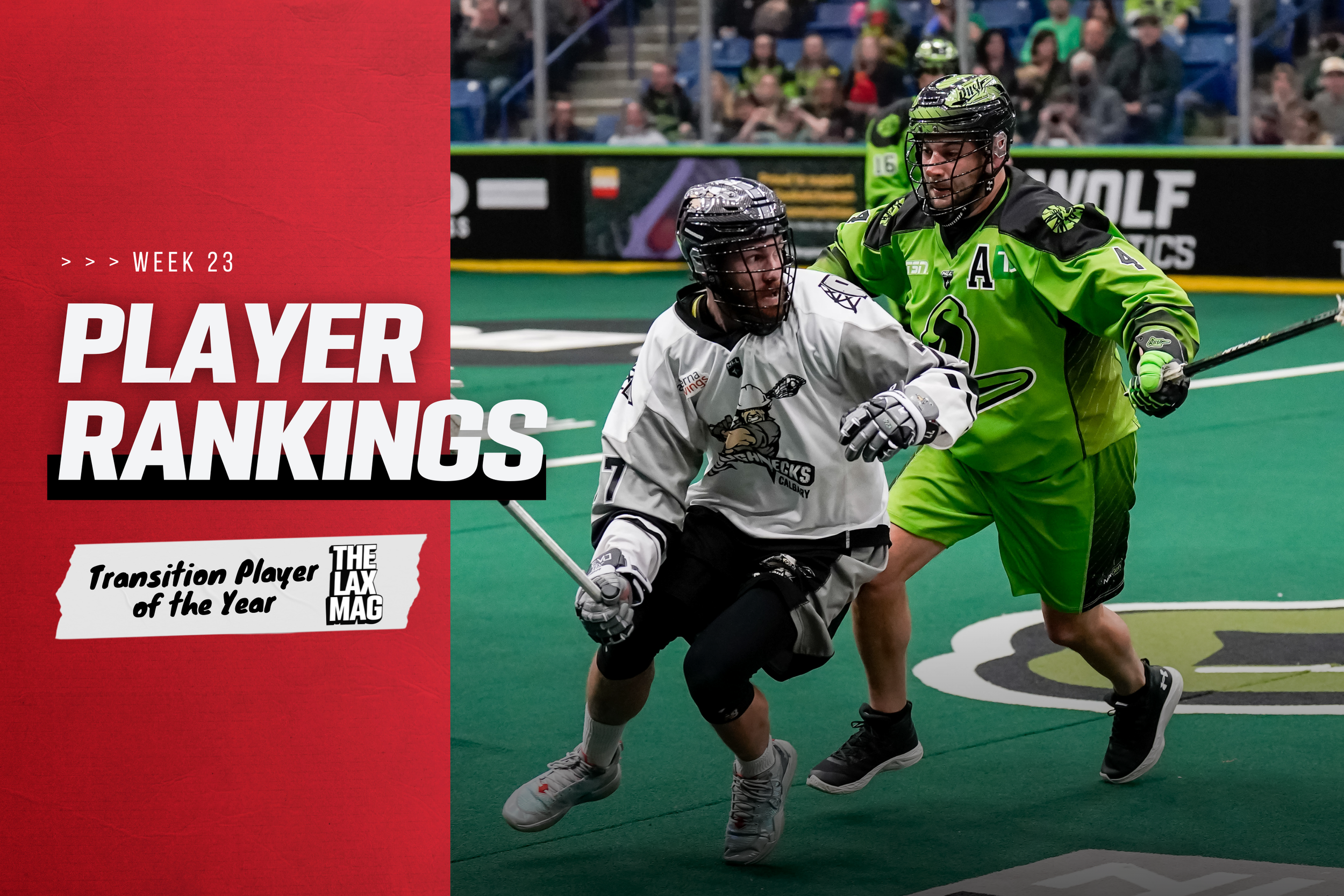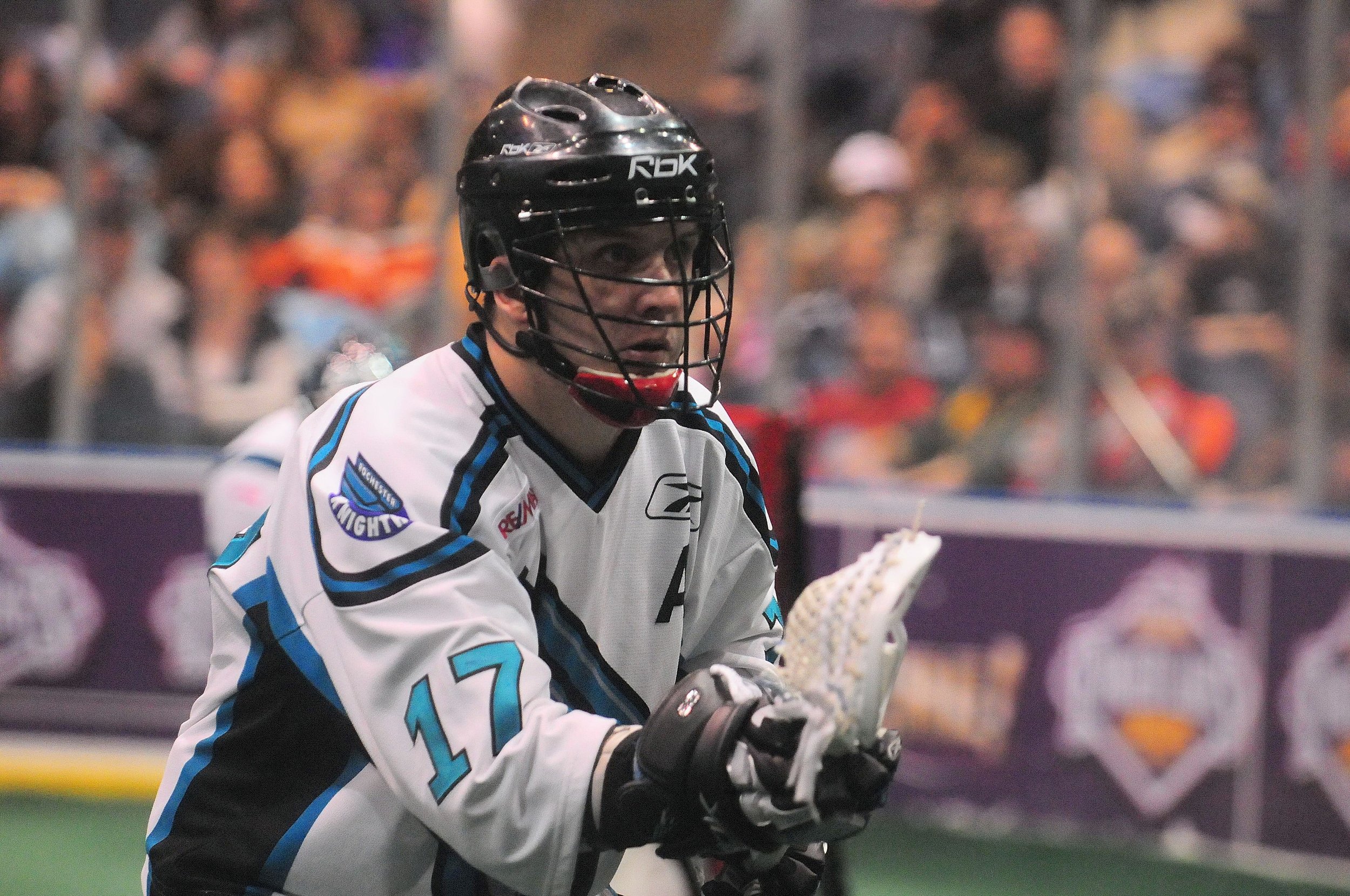NLL Player Rankings: Transition Player of the Year
During the 2021/22 National Lacrosse League regular season, The Lax Mag listed the Top 30 players weekly by highlighting each games’ top six players (for both teams), attaching a point value to their in-game rank (1st = 6 points, 2nd = 5 points, etc.), and averaging that out over the entire season.
For those that haven’t been following, here’s a bit more on how we calculate our Top 30, plus why we’re doing it.
With the regular season complete, over the next several weeks The Lax Mag’s NLL Player Rankings will examine the top contenders for the NLL’s major year-end awards, starting with Rookie of the Year and ending with MVP. The most valuable rundown will also include our final take at the Top 30 too.
Jordan MacIntosh, Georgia Swarm (Photo: Kyle Hess)
What defines a transition player in today’s NLL?
It’s the league’s most undefined position or role. We debated it’s meaning midseason, and long before that in the original pages of LAXMAG.
Many years ago, a league executive once confirmed that as long as a player had a T beside their name (as decided by their team), no matter what role they actually played, they could be considered for the Transition Player of the Year Award. No T, no dice. Hmmm, OK.
Since then, however, players defined as defenders by their team (D) have won the positional honour as well.
When you google “transition player lacrosse”, you don’t get a ton, but the Georgia Swarm’s website does have one of the rare definitions of the position:
A mix of forwards and defensemen, transition players can play on either side of the floor. They excel at getting the ball from one end of the floor to the other quickly and scoring on fast breaks, a change of possession from defense to offense before an opponent can swap their full defense out onto the floor.
And truly, when the award was first established, it was those types of players that the league intended to recognize: a defense-first player that was also highly impactful pressing up the floor and contributing to his team’s offensive output.
Steve Toll, the award’s first winner in 2007, is a perfect example of that type of player. A turnover-and-loose-ball machine on defense, absurd speed streaking up the floor, and then some offensive pop to top it off. These were players whose pure defensive skills would never win them DPOTY, and weren’t shooting nearly enough to ever challenge for the scoring crown either. With that said, their role was and still is immensely important, some would say most important even. It’s likely why most teams’ top transition player will typically have either an A or even C stitched into their sweater.
Steve Toll, Rochester Knighthawks
Transition players soon became so skilled that teams would often insert them into their offense, playing significant minutes up front and getting most of their points there (including the power play) versus flying the length of the floor and finishing (aka: transitioning).
When you look at the stat-lines for players that have won the award, it’s hard to get a handle on what defines transition or what voters actually look for:
2007 - Steve Toll, Rochester
Stats: 14G, 24A, 1PPP, 9SHP, 29SOG, 177LB
2008 - Mark Steenuis, Buffalo
Stats: 34G, 41A, 19PPP, 3SHP, 145SOG, 121LB
2009 - Brodie Merrill, Portland
Stats: 14G, 33A, 2PPP, 3SHP, 54SOG, 216LB, 0/0FO
2010 - Brodie Merill, Edmonton
Stats: 17G, 36A, 1PPP, 2SHP, 64SOG, 190LB, 5/11FO
2011 - Jeff Shattler, Calgary
Stats: 29G, 46A, 11PPP, 5SHP, 101SOG, 93LB, 12CT, 0/0FO
2012 - Andrew Suitor, Minnesota
Stats: 15G, 11A, 2PPP, 4SHP, 44SOG, 120LB, 25CT, 34/94FO
2013 - Jordan MacIntosh
Stats: 27G, 27A, 10PPP, 2SHP, 95SOG, 197LB, 14CT, 241/434FO
2014 - Jordan MacIntosh
Stats: 23G, 38A, 17PPP, 1SHP, 103SOG, 204LB, 25CT, 198/430FO
2015 - Joey Cupido
Stats: 16G, 15A, 0PPP, 4SHP, 37SOG, 117LB, 40CT, 2/4FO
2016 - Brad Self
Stats: 8G, 13A, 2PPP, 0SHP, 34SOG, 113LB, 18CT, 0/0FO
2017 - Brodie Merrill
Stats: 7G, 12A, 0PPP, 1SHP, 29SOG, 171LB, 29CT, 0/0FO
2018 - Joey Cupido
Stats: 16G, 11A, 0PPP, 6SHP, 36SOG, 111LB, 15CT, 0/1FO
2019 - Challen Rogers
Stats: 16G, 15A, 6PPP, 5SHP, 51SOG, 114LB, 19CT, 0/0FO
2020 - Challen Rogers (11GP due to cancelled season)
Stats: 11G, 14A, 2PPP, 1SHP, 42SOG, 51LB, 3CT, 0/1FO
While players that play the role in the traditional transitional sense have been awarded, so have those that are more about versatility versus playing that style the Swarm site defined. That’s no knock on any of the elite-level players listed above, but those can be two very different required skillsets, yet the NLL crams them into the same positional cupboard.
Challen Rogers, Toronto Rock (Photo: Ryan McCullough)
The NHL clearly defines their Frank J. Selke Trophy, which “…is awarded annually to the National Hockey League forward who demonstrates the most skill in the defensive component of the game.” Would hockey fans find it funny if one season the league’s highest-scoring defenseman was all of a sudden given the Selke? Yes, yes they would.
Who will win the 2021/22 NLL Transition Player of the Year Award?
Well, depending on what voters are looking for (as we’ve outlined, that changes frequently), here are your various leaders based on where they ranked in our year-long NLL Player Rankings:
Traditional Transition Player: Zach Currier, Calgary
Currier showed way-above-average athleticism, awareness and anticipation (like Steve Toll), led the league in loose balls (like Jim Veltman or Brodie Merrill), was tops in caused turnovers by a million miles (like, well, no one else), plus scored some critical goals for Calgary directly from a face-off or their press (again, like Toll). Other traditional transition players (that had a T beside their name) that ranked high in our rankings include: Mike Messenger (Saskatchewan), Tony Malcom (Albany), Ian MacKay (Buffalo), Ryland Rees (Rochester), Bryan Cole (Georgia), Chris Corbeil (Saskatchewan), Joey Cupido (Colorado) and Scott Dominey (New York).
Zach Currier, Calgary Roughnecks (Photo: Candice Ward)
O/D Transition Player: Challen Rogers, Toronto
The only player in the modern era that has come close to playing the role Rogers does for the Rock was Jeff Shattler during his MVP season in 2011, but not really either. Shattler split his season between starting out the back and front door almost equally. Rogers, on the other hand, is positioned depending on how healthy the Rock lineup is at either end and/or in-game needs based on opponent, scenario, etc. It’s a level of versatility that may have been required in early Major Indoor Lacrosse League seasons, but with the game so distinctively defined between O & D today, to play as effectively as Rogers always does is unheard of. Kiel Matisz (Philadelphia) and Jordan MacIntosh (Georgia) fit the criteria here too, and have for their entire careers, MacIntosh a two-time TPOTY winner.
Flipped Frank Selke Transition Player: Reid Bowering, Vancouver
Instead of the most defensively-skilled forward (although lacrosse has some of those for sure), the NLL has a number of high-profile pure defenders that can also contribute offensively too. Teams have defined these players on their roster with a D, but they could (or probably should) have been submitted as a T. Confused? Same. Anyways, this would include players like Reid Bowering (Vancouver), Mitch de Snoo (Toronto), Latrell Harris (Toronto) and Tyson Bell (Halifax). There’s a good chance these players will also get strong consideration for DPOTY too, especially de Snoo. Bowering gets the nod here though, the remarkable rookie leading all defenders in goals (13) and points (25), plus a crazy-good LB (214) and CT (34) count too. However you choose to define Bowering, 100% he’s winning the league’s TPOTY multiple times during his career.
Mike Messenger, Saskatchewan Rush (Photo: Jordan Leigh)
Face-Off-Stay-On Transition Player: Mike Messenger, Saskatchewan
In the back-to-back seasons MacIntosh won the award, he took nearly 900 face-offs over those two seasons. He had a strong stat-line across the typical transitional numbers a T player often excels in too. Although they never won the award, FO full-timers like Jeremy Thompson and Jay Thorimbert have been finalists in past seasons. It’s absolutely criminal that Geoff Snider, who checks off all the T-talent boxes, including dominating at the dot, never won this away (we’ll get into politics another time). We dropped Messenger’s name in the “Traditional Transition Player” spot up top, but he’s without question #1 here. The Rush two-way talent played hard-hitting defense, scored, set up, scooped, picked, powered the press, popped turnovers, fought and faced off.
So, our highest ranked player of all the very versatile talents just mentioned?
He’s been a league finalist the previous three seasons, but our season-long tracking of this year’s top players tells us Zach Currier should finally be named the NLL’s TPOTY this year. If his game isn’t deemed award worthy with the season he supplied Calgary this year, it never will be.






